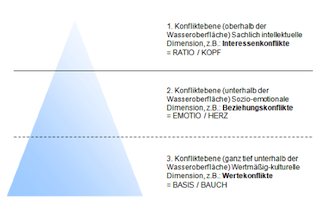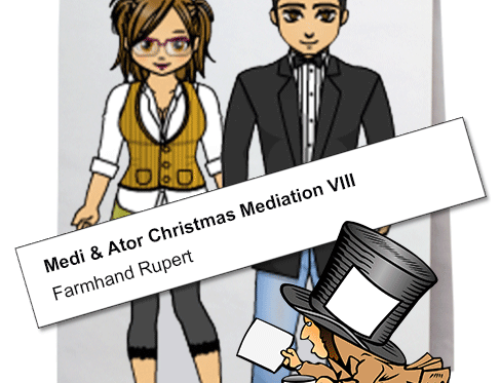The short over the snake-pit
Once upon a time a colleague of mine told me: “We have to cross the human snake-pit if we want to resolve their conflict”. He was a psychotherapist. And he was right. What he described is the difference between facilitative and transformative mediation. It was Christoph Thomann, a famous mediator from Swizzerland who told that.
A student of mine recently mentioned in an interview: “As a mediator I feel like being in a room where you will find a plug at the one end and a plug-in at the other end. Me as a mediator I try to bring them together in order to close the circuit”.
I told him: “Then you have to break the wall where the plug-in is fixed if you want to bring both together in the middle. Or you will have to convince the plug moving towards the plug-in at the wall. Do you think you will be able to convince that plug?”. Then he answered: “I will offer an extension cable. Then plug and plug-in might approach each other where ever they like and nothing needs to be broken”. This was Igor Albanese who presented that nice metaphor. He proved to really have understood what mediation is.We now understand that mediation is:
Finding ways how people get together where people will find ways themselves to overcome their problems.
Maybe there is both in mediation. A snake-pit and a current flow which has to be restored. At least these are pictures helping us to understand what is behind the transformative mediation and how mediation works as a cognition process.
Passing the snake-pit definitely is no joy for anybody. Good if we know the shortcut and the most secure path getting over the snakes. This path we may call transformative mediation. It also is used by integrated mediation.
The springboard of that path over the snake-pit definitely must be the parties’ conflict. The conflict is the evil of everything causing that mess people are suffering from. Suffer nobody wants to have. In oder to get rid of it, people ususally start to eradicate what is causing that conflict. They assume to know the solution as well as the reason causing that conflict. They also know who is responsible and who has to change it. Thinking like that, they land directly among those snakes in that snake-pit. This happens on both sides.
Crossing the snake-pit securely, we have to think in other terms than we have been taught over the ages. No, it’s not a remedy to whitewash conflicts I am talking about. Conflicts are as they are and mediation is not to talk things nice that are ugly. On the other hand, persuading us that conflicts are the means to change something, is not really convincing as well. It draws the picture of a very poor world where conflicts are meant for developments, doesn’t it? Of course this statement depends on how we define conflicts. Maybe it helps to have a more differenced view on what conflicts are. We start distinguishing problems from conflicts. This is necessary as we deal differntly with problems or with conflicts. Now let’s state that:
There is a difference between conflicts and problems like between fight and contention.
To resolve a conflict efficiently, we’ll have to go a very different way getting out of that mess. Repeating patterns that are proved to be useless doesn’t help. Celebrating conflicts doesn’t help as well. Maybe it helps to not look at the conflict we have to resolve. Conflicts are not able to do something. They are just a phenomenon and definitely no actors. The actors poeple are. Conflict theories try to describe that behave and to find reasons for it. They want to show ways out. The research concerns human behaviour. Lets follow those insights and have a look on the humans more than on a phenomenon. We then will not have to resolve the conflict but our understanding of the facts and behave causing what we describe as to be a conflict. Adressing the conflict is focussing us on what should die. Instead and better if we address what should survive. Now our focus is directed into the future trying to understand the development getting there. Let’s take a look on what is behind the conflict.
What is behind each conflict is development.
Development always is based on tension. Let’s come back to Igor’s metaphor. We have in mind the picture of a current flux. With electricity tension is measurable. The measure is called ampere. If we compare conflicts with electricity, the measure is conflict escalation. Both is measuring the strength. Electricity needs two poles in contradiction. A positive and a minus pole like + and -. Power is on, where both poles exist isolated from each other. Electricity needs that contradiction of + and – but not the clash. Tension between + and – is necessary to let electricity flow. At the end it will close an electric circuit. Where those poles come into contact with each other, they’ll cause a short, the breakdown of power and the loss of electricity. Tension gets out of balance. Let’s define conflicts now as to be (the danger of) a short of tension.
Conflict is like a short over a snake-pit.
Nobody needs a short to make things possible. The only thing what is needed is to repair the electric system, by isolating the poles and recreating tension in its balance.
What conflict is doing, is warning us. If we do not care for tension, we might expect a short. We also might expect the system breaking down, where we ignore the warning. Now let’s see conflict as to be a hint that something is wrong, important enough that it has to be regulated. Maybe because of that, conflicts might be helpful as they tell us what is important for us. For things that are not important we wouldn’t invest any energy to correct what is running wrongly. Maybe we take conflicts as that and as a motivation to act.
Where the conflict is the signpost to change something, it also is the signpost to mediation. There is no other procedure and no other way of dealing with contradictions as good as mediation can. This has to do with the way of thinking. Mediation takes us out of those + and – poles, releasing us from evaluation. A mediator is like the electrician who helps isolating those poles to overcome the short in order to close the electric circuit at the end again. Mediation in its combination of logical and dialectic thinking is unique. And it is a good approach for contradictions and issues that seem to be unresolvable at all.
Identifying a conflict is the first condition for doing the mediation.
To identify the conflict we need to know who is in conflict with what and whom. This is a crucial question as it firstly is important for organizing the mediation and secondly it is important for better understanding the issues we later will have to talk about. As mediation is complex and people are complicated enough, the simple rule is: Talking about isolated issues with as less people as possible. Keeping things simple and easy. For that we need to know who is in conflict with whom and what about. If its getting complicated we start to draw conflict maps.
Conflict maps help localizing and qualifying the conflict.
The aim is to just talk with those who are in conflict with each other. And to be sure that those we are talking with are stakeholders of the conflict. Now we assume our parties are the right stakeholders. They are the owners of the conflict. Then we might step to the next condition we’ll have to check for getting the mediation running properly.
As the next we’ll have to prove whether parties want to restore the electric system to let electricity flow again rather than to move into another house where they will find another electric system they suppose to work properly. Not sure if that is an option where parties stuck in any kind of staying relationship or where they do not want to leave all those things behind in that house they are going to leave. Better to transform the conflict to something that can be a new base for future. This is what transformative mediation wants to achieve. The means is to look into future by learning from the past.
In order to resolve anything parties must be aware of their contradiction.
Even more they need to accept it. They’ll have to learn that electricity needs two poles, plus AND minus to flow. Isolating the poles and recognizing them is the first mediator’s challenge as humans do not like contradictions. They try to avoid cognitive dissonances by changing their understanding and perceptions. “Two poles for electricity? No, my system runs on one pole solely!” is the way parties try to comfort themselves. The other pole is too much to play with in their game. “It’s just the zero conductor”, they argue. “For what should I need a zero, which is a nothing?” they continue trying to convince themselves. Now it will be the first mediator’s task to open the parties’ mind for accepting the contradiction. Not to resolve it but to recognize it as that. Otherwise the electric system cannot be repaired. This is heading to the next condition we need for mediation:
Parties need to understand the indissolubility of their way dealing with the conflict.
The more parties understand that their confict is insolvable, the more they will be ready for searching other solutions. That’s what mediation is made for. Approaching the contradiction they need to understand that contradiction is not a problem at all. The problem is what we are doing with that. Mediation splits the contradiction and what we are doing with that in different phases. What we are doing with that will be discussed in phase 4. This is to free the mind for the contradiction, which also will be isolated in a way that balance will become possible afterwards. Before we need to accept that there are plus and minus poles. Afterwards we can find the way in between those poles. these structures of thinking will be organized by mediation. The mediator just takes care that mediation can do its work.
The journey of transformative mediation therefore starts with three simple conditions:
- There must be a conflict
- People like to overcome it
- They are ready to searching for (other or better) solutions
We now are in a searching game. The challenge of that game is: nobody knows what to look for and where. The only thing we know is HOW to look for what we do not know what it is. This know-how for looking is described by mediation pretty well and step by step.
There are 5 crucial steps.
The first step is to organize the way to go over that snake-pit without stepping in it. We fix some conditions to assure, that at least this way will be free of conflicts itself. We keep it free by not deciding for plus or minus pole. This is why neutrality is so important. Only if we are able to have those both poles in view we can find orientation to go between them. This all will be agreed in phase 1 of mediation.
The second step, which is phase 2, is to allow contradiction to be. To learn that we need two poles a plus and a minus pole to switch power on again. The mediator does this by listening to what people are complaining against each other. The same time he collects some information, inspiring him and the parties to what it is that we are looking for. This is called a hypothesis.
Hypotheses are the torch for finding solutions.
We are in a situation like searching something we do not know what it is to be found in that darkness of our messy brain. We are searching where nothing is visible. Mediators are used to those situations. They learned to not taking care for things we lost. They know everything is good for something. We do not need to know WHY it is good for something, just WHAT it is good for. Brain is not able to answer this question. Brain tries to asnwer that WHY. So why torturing brain with arguments and reasons we do not need to know?
As we do not know much about the parties’ conflict at that time, we take those few information and assume what the conflict could be. Our interest is to find the motor driving parties’ to such a behave. Human’s motor is motivation. Now mediators wonder: “What could be the motivation to fight against the other side so much?” The reason why we ask for motivation is to find the funds of satisfaction. Motivation always end in satisfaction, not in reasoning. That’s why motives are that interesting in mediation. What we learn now is to think into another direction. Mediation provides it for us. It is NOT to look into the past who has done something wrong and how to repair a damage.
The view of mediation is to look into the future how things should be instead.
Yes I know. It is easier for humans to look on what is wrong than to say how it should be right. The reason why that is so difficult to answer how things are fitting to the needs the best is because this answer cannot be given by brain. The answer is given by our hearts.
Our hypotheses now try to figure out the following:
- What is the conflict, motivating people to fight against each other such a way?
- Who is involved in that conflict personally and how?
- How deep is that conflict?
- What kind of conflict do we have to face?
This will be our conflict analysis. If there are many conflicts overlapping or more people in that game, we will have to draw a conflict map. The idea is to invite only those, belonging to single conflicts to not make things too complicated by separating each conflict, we talk about. The conflict itself is complicated enough.
The idea that parties will find the solution themselves needs to clean the mess in their brain. Precise listening is the tool for that included in (integrated) mediation. We try to understand the whole complexity. This is to broaden the room of thoughts where we can find solutions. People are used to simplify things. Simplification is reducing. Reducing is focussing and focussing is like closing eyes. As we are searching something, we do not know what it is in the darkness of our brain, where we are not able to see anything, it is a need to open eyes as wide as possible. Mediation helps by giving structures and order for seeing all the dimensions of complexity we have to face. It is the only procedure able for that. Opposite to the court we do not just look onto facts. We see the whole person but we separate personality from facts, opinions and emotions having a look on everything but isolated from each other. That’s the trick.
Coming back to the hypothesis: Knowing the type of conflict helps to choose the right model of mediation and the strategy how to get along that snake-pit without stepping in it. There are many kinds and styles of conflicts, not really helpful for predictable approaches. What really helps is to differ dimensions of conflicts. This is like going back to the human roots.
There are 3 crucial dimensions, we always have to face:
Mind (Rationality), Feelings (Emotionality), and Personality (Imprinting). Interesting to learn that these fields of conflicts are connected with Glasl’s dimensions of conflict escalation. It’s more interesting to understand that they are referring the 3 centers of human intelligence. Its not a wisdom but a need to be remembered all the time that our intelligence is not just what brain is telling us. The conscious covers not more then 5% of what we could percept. That – you might agree – is never enough for decision taking. The centers of human intelligence therefore are distributed like follows: ratio (which might be located in our brain); emotions and relationships (which might be located in our heart); and personality together with identity and self-determination (which might be located in our stomach), where instincts are situated. “Listen to what your stomach is saying!” or “Listen to what your heart is saying!” is a good friend’s advise we often hear. Of course seen from a medical or biological point of view the nerves will lead to other regions in our body. But it is an old wisdom to locate intelligence distributed all over our body including the organs in it.
When doing the mediation we all have that in mind. And we become curious to learn the richness of life expressed in the parties’ conflict. Conflcts often are compared with an iceberg. What is visible above the water surface is just the brain’s affair. Our iceberg has two further levels deeper and deepest under the sea. Together with the parties we decide which level of intelligence we like to address. If they want to transform the conflict, there is no other chance than getting on the deepest level possible.

The deeper we dive the darker it is. But that should not become a problem. Our hypotheses are giving us some kind of a torch. It also helps us passing the snake-pit, not stepping on the poles and looking for something in between we do not know what it is.
If what we are looking for is in the brain, we have to look up and we should think about. If it is in the heart we have to look inside and to understand the feelings. If it is in the stomach we have to kook into the very depth of us and to find ourselves.
Now we also know the model of mediation to be used and the kind of interventions. For conflicts where brain is involved, we use facilitative mediation. For conflicts where heart or stomach are involved, we use transformative mediation. Knowing the escalation gives another information that helps planning.
Opposite to Glasl’s theory, there is not just one conflict escalating. The conflict is exceeding and spreading. A rational conflict will become accompanied by an emotional conflict and on those higher steps of escalation there will include an imprinting conflict as well. Seeing the conflict map like that gives us a more differenced picture of conflicts and a strategy how and what conflict we’ll have to face first.
At that moment, we are still in phase 2 of mediation, we have already some ideas how we should look for what we do not know what it is. Thus we listen to the stories of the parties. Every party has its story. Depending on the conflict dimension, we focus brain, heart or stomach, when listening. Over all we hear the story without focussing anything, just the history and the context. No need to deeper think about. The impression is what counts. The picture people draw and the metaphors they use. We take those pictures now having the context in mind allowing a broader view on everything that will not get lost in stupid details. We wonder, how parties find themselves in those pictures and where the piuctures are overlapping. This is to understand what they have in common or not. Things they have in common we do not need to talk about though we need to point them out. It’s a phenomenon that parties forget that there mostly is much they have in common. This again has to do with the way of thinking and focussing things that do not really help finding ways out of that snake-pit.
When parties tell their story, they tell a lot about themselves. Maybe they are seeing themselves to be bagger, looser, victim or hero or …Whatever they are, they will define a role for themselves. And even more. If we are able to really listen precisely and carefully, we will hear the role they like to have. Some like to stay a victim, others like to become a hero. This is up to the parties themselves and not to us to decide.
On the first glance, the stories parties are telling might look very contradictionary. On the second glance they almost look identically. And there is the view over everything which allows to see the context, each story in it and the different roles and fates.
Mediator needs to have three views in mind (the view of the one and the other party and the meta-view). One view for sure he shouldn’t have, that is his own view on things.
Ok that’s a point now. We are at the end of phase two and we might leave things as they are in all their contrariness. Then we take a deep breath.
Its time to check our hypotheses. If the issues the parties told before are fitting to them, everything is fine and we still are on the right way to where we do not know what we are looking for. If not, then we will need to find new hypotheses in order to exchange our torch.
Maybe now when phase 3 will start, you might be afraid of the snake-pit. Seems we have to trespass it and snakes are not that nice. You have to be careful. If you hit one, it might bite and snakes are poisoning. Hitting a snake means to decide for one of the poles, to justify or to reason what has happened in the past.
So we decide to better not step in that.
We haven’t forgotten, that we still are looking for something that should resolve the conflict. We do not want to disturb those snakes too much. And we still do not know what we are looking for.
Now we are using a trick. To avoid that snake-pit as much as possible we do not search where we have lost something. Instead we imagine what could be the benefit behind that snakepit. What would it help you if you receive what you claim, is the question. Parties will tell what they have in mind by directly or indirectly thinking of the conflict they like to overcome. And we will have a view on both. On the damage and the benefit.
Isn’t that focussing the scope where the solution will be quite nicely?
People in conflict are driven to attack each other. Not always they like it as it is a waste of energy on the one hand. On the other hand it is a source of energy. It doesn’t make sense to fight against a gush but to use its energy and redirect the current. Now attacking each other is telling us again a lot about those who feel the need to attack. That’s our focus. We face the I-massages.
Why are we doing so? Its not our attempt to make a diagnosis and to give advise to people what they should do. Like Socrates we believe everybody bears the truth of life (in our case the solution) inside. We just need to help it to birth. The techniques Socrates invented therefore was called the midwifes technique. We wonder: Why do parties need to behave as they do? This is not to analyze them but to improve our torch.
Now we turn to psychology to help us finding what we still do not know what it is. We learn that people are driven by motivation. There are 2 kinds of motivation. One is for growing, the other one is for overcoming lacks. We assume the motivation is to overcome a damage and we imagine the motivation to row is over when the lack is stuffed. What we are looking for is satisfaction.
The only reason to learn about the parties lacks is to understand what could be the satisfaction.
But what is the lack? That we will find among the needs. Needs we do only have when things are lacking. You are hungry only if you starve. Now we become interested to learn about the needs. “Why is it important for you to do what you are doing?” might be our question. We listen to the words, but if the conflict is on the heart’s dimension even more to what the heart says.
The heart is the guidance of life heart and stomach know better what is good for us then brain. We therefore isolate what heart and brain and stomach are telling and listen to each of them. There might be another contradiction coming up now. It seems to make things more complicated. For many people this is reason enough to not look to there. But we are mediators. We do not care for that. We know at the end this doesn’t matter.
Listening to all of that we have more and more stories to be respected. The stories of the parties, the stories of their brains, the stories of their hearts and stomachs, and every story is unique and not really fitting to each other.
If the heart is the signpost of life, we carefully listen to what the heart is saying.
Probably people will not be able to tell where to go. But they will be able to tell what is wrong. Now that is information as well and we take it as such. Not to search in what is wrong. We still do not know what we are looking for. But we know we will NOT find it in what is wrong. But we will find it in the opposite.
So we listen to what is hurting and compromising, not to understand that but to find the opposite in it.
That must be the way to go. We make it visible to the parties and see if it is right or not in their reactions. When we see it is right we keep that idea. We keep it as such isolating it. Otherwise brain will start to evaluate what we just found. This will destroy the coin.
That way we collect very little coins as to be bricks in our minds. People wouln’t see them, because those coins, they think, are not at all close to any kind of solution. But that is not correct. Coins are part of a treasure like waterdrops are part of the sea. Without waterdrops no sea. Without coins no treasure. Thus we keep on collecting those coins in an almost stubborn way like a brains storming, one by one. We will see that the Parties mind slowly will open itself. They can see more and differently than before and suddenly they will understand that those coins are insights.
One step further after we learned that parties are able to see that they are like treasure hunters, where the treasure they find in themselves, we try to now let them focus the other side. before our view and the parties view was focussed onto themselves. This was to not become irritated in hat process of understanding. While we – till now – have been concentrated on each of the parties isolating their mind from each other like those + and – poles of electricity, we now – after we learned that there are two poles – try to built a bridge. This is to enable tension in a balance. We still are far away from that. But like a little child who is teared between security and exploration instincts, they will be able to smoothly have a careful view onto the other side, as it is and not as they pretend it to be. If that works we let parties slip under the skin of each other. If they are able to stand that view, parties are ready to now offensively look for the treasure. We reached end of phase 3.
At that moment, we still do not know what we are looking for. But we have already some coins and we just need to collect those we need for solution. That is phase 4 now.
We have passed the snake-pit now and we didn’t have to step so deeply in it. That will be seen as comfort. A typical reaction of parties is: “It was so good to tell and to see the other side listening!” If that is an experience people gain they can stand any decision coming out of that. We learned about the parties’ conflict without diagnoses and therapy, we often even do not need to talk about resolving the conflict though. That is one reason why mediation is such a good procedure, why it is quick and sustainable the same time. We do not get lost in stupid arguments, justification and reasoning.
Sometimes, in highly escalated conflicts we need to step in that too. But this depends on case and circumstances. We as mediators need to know where our own borders are. If they are reached it doesn’t mean mediation is the wrong procedure. It just means I am the wrong mediator for that case.
Coming back to the parties’ affair. We are in phase 4. The idea is to let people phantasy about solutions possible and desirable. Now we have to face another problem. Phantasy is limited by brain. “Ah I would like to BUT …”. This “yes but” is canceling all the good thoughts which might follow up. Then there is another danger. If one party suggests something the other party will start to argue age ins that proposal. If you allow that parties will fall back to phase 2. Now the directive of mediation is to not allow thinking. Mediation is schnaging its face and rhythms. While we took all the time of the world before to allow thoughts coming up in our brain, we now want them to stay out. The trick for that is to allow every thought, to not think about and to accelerate the process. The ideal way is if parties are able to make offers to themselves. Not always they are ready for that. Then it is enough they just mention ideas for solutions if they are possible or not.
In another step of phase 4 we slow the process down again. Now we ask parties to evaluate themselves what is a good idea and what not. Now we can discuss the proposals. And you will see, it works. It works the better the more positive ideas have been collected the step before. Help them to find those positive ideas.
Now the second part of phase 4 we allow thinking again. And we switch from dialectic thinking back to logical thinking. “Is it a good idea?”, “Do you like that idea?”, “What is not good in that?” “What is missing that you can approach that solution?”, “Are there facts we need to clarify first?”.
You see that we start negotiation now and not before.
We’ll have to check if the solution the parties found fits to their needs and the interests (motives) behind. We have to check if they could bring satisfaction. Then we have to check whether the interests fit to the issues and whether the issues fit to the hypotheses. If everything fits together we can be sure the solution is the right one and it is overcoming the lack to enclose the parties’ lack.
We still do not know what we have been looking for. But that doesn’t matter as people always get what they need and never what they want. We know parties got what they needed. What else do we need to know?






Leave A Comment
You must be logged in to post a comment.